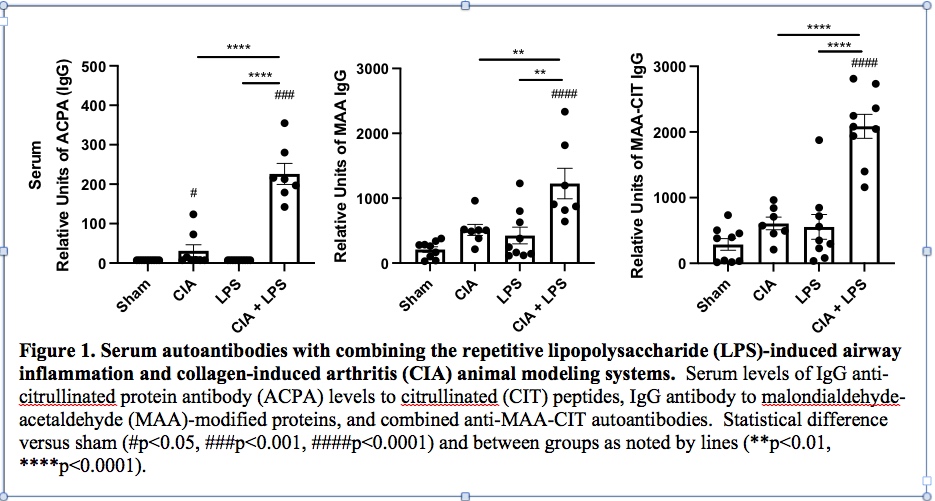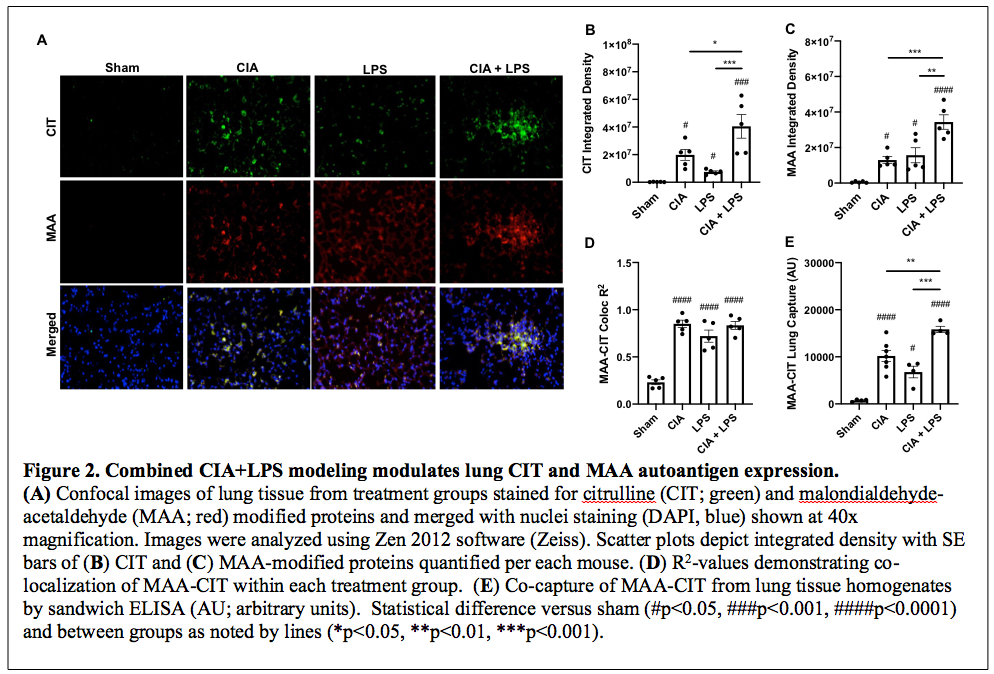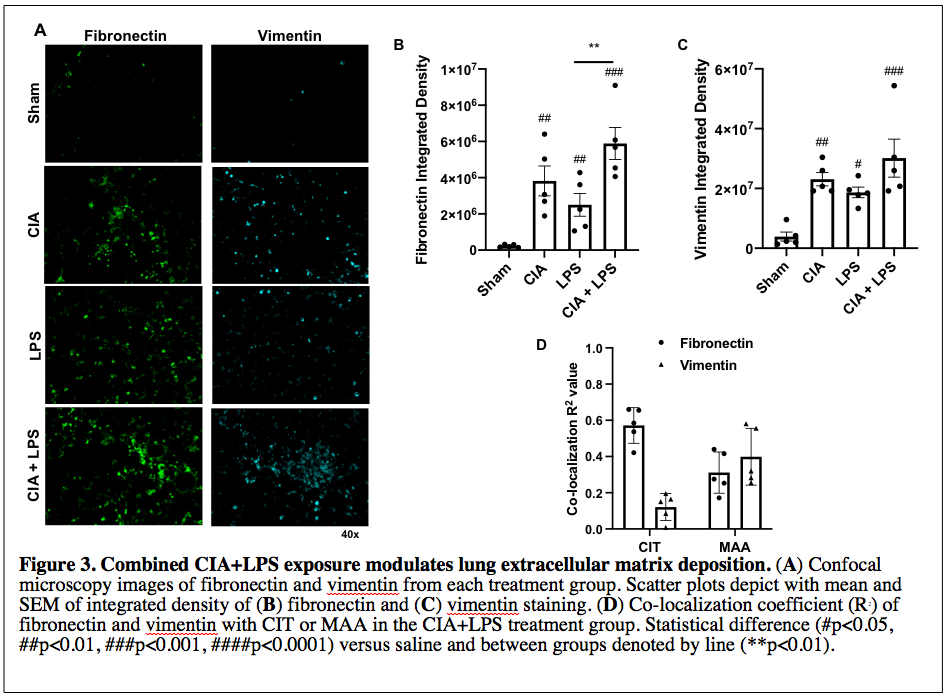Session Information
Session Type: Poster Session C
Session Time: 8:30AM-10:30AM
Background/Purpose: In addition to inflammatory arthritis, collagen-induced arthritis (CIA) recapitulates cardinal features of rheumatoid arthritis (RA) including autoreactive T cells, peptidyl-arginine deiminase expression, and citrullination of synovial antigens. However, CIA is not characterized by robust ACPA expression, a key limitation of this model since ACPA are highly disease specific and play a pathogenic role in RA. Airborne biohazards such as cigarette smoke have been linked with airway generation of citrullinated antigens, ultimately leading to tolerance loss and ACPA production. In prior work, we have shown that combining the inhalant exposure of lipopolysaccharide (LPS; a component of relevant environmental/occupational exposures in RA) with CIA amplifies arthritis and shifts airway inflammation seen with LPS alone towards lung fibrosis. In this study, we examined the effect of repetitive exposure to airborne LPS on airway formation of autoantigens and circulating autoantibodies in CIA.
Methods: DBA/1J male mice were assigned to 4 groups: 1) Sham (saline injection/saline inhalation); 2) CIA alone (CIA injection/saline inhalation); 3) LPS alone (saline injection/LPS 100 ng inhalation); and 4) CIA+LPS (CIA injection/LPS inhalation). Serum and lung tissues were harvested at 5 weeks. ACPA (IgG) and antibody to malondialdehyde-acetaldehyde (IgG anti-MAA [also increased in RA] and anti-MAA-CIT antibody) were measured using ELISA. Lung tissues were examined for citrulline (CIT), MAA adducts, and extracellular matrix proteins (fibronectin, vimentin) using immunohistochemistry. Pearson R2 values were calculated as measures of tissue co-localization.
Results: Serum ACPA, anti-MAA, and anti-MAA-CIT antibodies were strikingly potentiated in CIA+LPS vs. all other groups (p< 0.01; Figure 1). Both CIT- and MAA-modified lung proteins were significantly increased in CIA, LPS, and CIA+LPS vs. Sham, with the highest expression in CIA+LPS (p< 0.01 vs. all other groups) (Figure 2). CIT and MAA co-localization were similarly increased across groups vs. Sham. Lung fibronectin was increased with CIA and LPS and its expression was enhanced in CIA+LPS (Figure 3). Vimentin expression was increased in CIA, LPS, and CIA+LPS vs. Sham, but there were no differences between treated groups. In CIA+LPS lung tissues, CIT co-localized with fibronectin (R2=0.6) but not vimentin (R2=0.12), whereas MAA co-localized with both fibronectin (R2=0.3) and vimentin (R2=0.4).
Conclusion: In the context of arthritis induction, exposure to endotoxin (a ubiquitous airborne biohazard) led to substantial increases in the lung expression of post-translationally modified proteins implicated in RA. Moreover, these combined exposures led to striking increases in serum autoantibodies including a >30-fold increase in ACPA and a 6-fold increase in anti-MAA antibody, yielding an autoantibody profile more closely mimicking human disease. These results emphasize that an underlying predisposition to autoimmunity plus a “second hit” such as an airborne biohazard exposure could be driving tolerance loss and autoimmunity that characterize RA.
To cite this abstract in AMA style:
Mikuls T, Gaurav R, Thiele G, England B, Wolfe M, Shaw B, Bailey K, Nelson A, Duryee M, Hunter C, Romberger D, Ascherman D, Poole J. Enhanced Expression of Rheumatoid Arthritis Related Autoantibodies Following Airborne Endotoxin Exposure in the Setting of Collagen-Induced Arthritis [abstract]. Arthritis Rheumatol. 2021; 73 (suppl 9). https://acrabstracts.org/abstract/enhanced-expression-of-rheumatoid-arthritis-related-autoantibodies-following-airborne-endotoxin-exposure-in-the-setting-of-collagen-induced-arthritis/. Accessed .« Back to ACR Convergence 2021
ACR Meeting Abstracts - https://acrabstracts.org/abstract/enhanced-expression-of-rheumatoid-arthritis-related-autoantibodies-following-airborne-endotoxin-exposure-in-the-setting-of-collagen-induced-arthritis/



